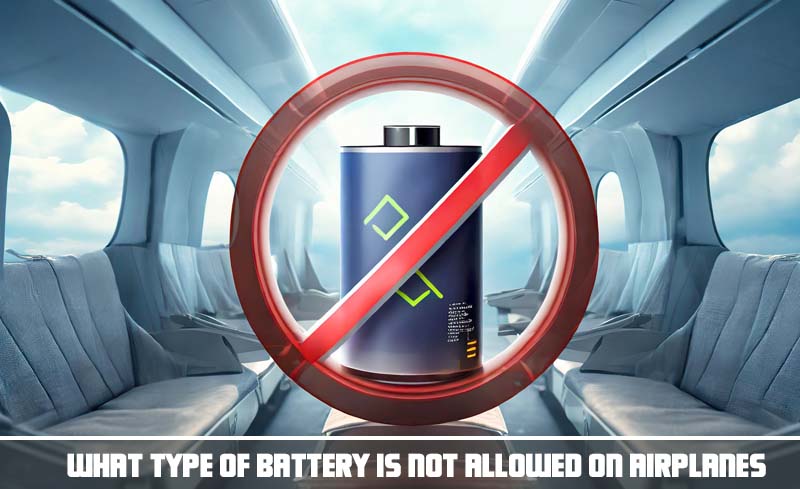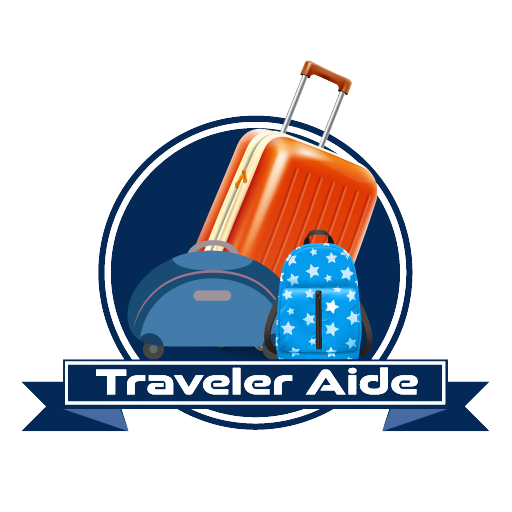As a seasoned traveler, I know how frustrating it is when your batteries die at the worst times, like on long trips. I’ve learned what you can and can’t bring on planes. For example, batteries come with their own set of rules. This is especially true for high-energy lithium batteries. Not all batteries are created equal. Lithium raises safety concerns at high altitudes. They can overheat, short-circuit, and even spark flames.
This is not ideal when sealed in a metal tube seven miles up. Because of this, lithium batteries, including portable chargers, get VIP. They ride along in your carry-on, where the crew can keep an eye on them. Lithium metal batteries face the strictest limits. Spare batteries are banned altogether, even in your carry-on. Lithium-ion batteries, like those in most of your electronics, can come too.
However, their capacity is capped at 100 watt-hours per battery and less than 2 grams of lithium. Remember, watt-hours measure how much charge a battery holds. Keep them relatively low.
In this article, I will share TSA rules, different battery types, limits, and how to pack. So let’s go to start.
Why Lithium Batteries Are Restricted on Airplanes
Lithium batteries, in particular, require extra caution. They can overheat and cause fires. That’s why airlines restrict the kinds of lithium batteries allowed in checked bags. They also limit the kinds of lithium batteries allowed in carry-ons.
Lithium Metal Batteries: High Risk, Not Permitted
Lithium metal batteries pose the biggest threat. So, spare lithium metal batteries aren’t allowed on planes at all. Only batteries built into devices are permitted. These dense batteries pack a lot of energy for their size but are more volatile.
Lithium Ion Batteries: Carry-On Only, Capacity Limited
Lithium-ion batteries, like laptops and phones, are safer but still restricted. You can bring lithium-ion batteries in carry-on bags only. Each battery’s watt-hour rating must be under 100 Wh. Watts-hours indicate how much energy a battery holds, so the lower, the better for flying. Batteries also can’t contain more than 2 grams of lithium.
Follow the Rules and Fly Safe
Check the TSA website for the latest guidelines before you head to the airport. Pack spare batteries in their original packaging or protective cases and label them. Refrain from overstuffing your bags with power banks. And consider using devices on internal batteries when possible during your flight.
Following the rules, we can all fly safely with our lithium battery-powered essentials. Knowledge is power. Spread the word about lithium battery safety to fellow travelers. Together, we’ll keep rerouting these tiny energy sources. We’ll prevent them from becoming in-flight hazards to aviation adventures!
Prohibited Batteries in Checked Baggage
As I’ve learned from many trips, some types of batteries can’t be checked as luggage. Lithium batteries, particularly, need extra caution.
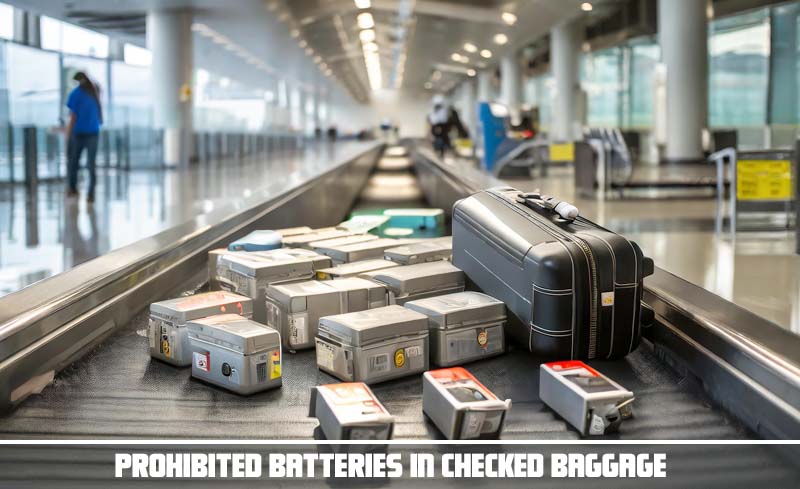
Lithium metal batteries are prohibited.
Spare lithium metal batteries of any size are banned from checked bags. Even though my wireless headphones came with a spare set, I pack them in my carry-on to keep an eye on them.
Lithium-ion has limits.
You can bring lithium-ion batteries on the plane, like those on my laptop, phone, and portable charger. But only in specific ways. Each battery must be 100 watt-hours (Wh) or less, totaling 160 Wh per device. My laptop battery is only 60 Wh, but my portable charger is a whopping 300 Wh- too big for checked bags.
TSA guidelines apply
The TSA website lists the specific rules for different battery types. I check their site before every trip to ensure my tech gear reaches my destination. Their pro tips, like packing spare batteries. I have saved myself more than once from having items confiscated at the checkpoint. I keep and choose my portable chargers in their original packaging and fill my bags with them.
While the rules may seem inconvenient, they exist for our safety. Lithium batteries in the cargo hold could overheat, ignite, or even explode. I rest easy by following guidelines. I also limit higher-risk batteries to my carry-on.
My tech and I will start our adventures with peace of mind. What are your tips for flying with batteries? I’d love to hear your stories!
Restrictions for Carry-On Baggage
You can bring lithium-ion batteries in your carry-on. But there are limits. It applies to batteries in phones, tablets, and power banks. Each battery must be 100 watt-hours or less. You can carry more than two lithium-ion batteries per carry-on. Lithium metal batteries are typically non-rechargeable. They can’t bring carry-on bags because they are so unstable.
Since I fly a lot, I always ensure that any lithium batteries in my carry-on are secured. I keep them in their original packaging or a sturdy case and labeled.
I also avoid overpacking many high-capacity power banks. I use my devices’ built-in batteries when possible. Check the TSA’s website for the most up-to-date rules before going through security. Here are some tips for flying safely with lithium batteries. Pack spare batteries in carry-on only. Label batteries. Don’t overpack power banks.
Use the device’s internal battery when possible. Share the rules with fellow travelers! Follow the guidelines and use common sense. You’ll breeze through airport security with your essential devices and power sources.
Restrictions for Lithium Metal Batteries
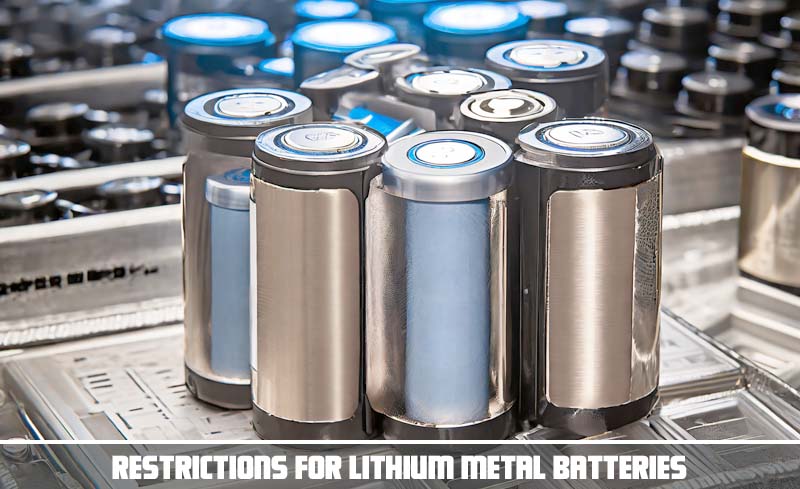
Over the years, many different gadgets and gizmos have helped me get through airport security. But some batteries need extra caution, especially when flying. These lithium batteries can lose their charge at high levels. They are used in a lot of portable tools and vape pens. The TSA regulates them.
Metal lithium batteries are an outright no-go in carry-on and checked baggage. These non-rechargeable types are used in cameras or watches. Even small amounts of lithium metal raise safety concerns. Spare batteries are prohibited.
Lithium-ion batteries are rechargeable and used in most consumer devices. They are allowed but with restrictions. Each battery can contain no more than 100 watt-hours of energy and 2 grams of lithium content. Think of watt-hours as the total battery “juice.” Many power banks meet this limit. But, some higher-capacity models still need to Check specifications to be sure.
When flying with lithium-ion batteries, always pack them in your carry-on luggage. This way, they can be monitored. Stow them in the original packaging or a sturdy case. Attach a label indicating they contain lithium batteries. Pack only a few batteries in one carry-on; spread them among your bags. Consider using your devices’ built-in batteries whenever possible on long flights.
The TSA website details the types of batteries allowed and not allowed on airplanes. It also provides safe packing tips for your lithium-ion friends. Their guidelines change, so check for updates before you travel.
Following these rules and suggestions, you won’t have to worry about taking your tech toys on the road. If you want to travel safely by air with lithium batteries, know that less is more.
Restrictions for Lithium Ion Batteries
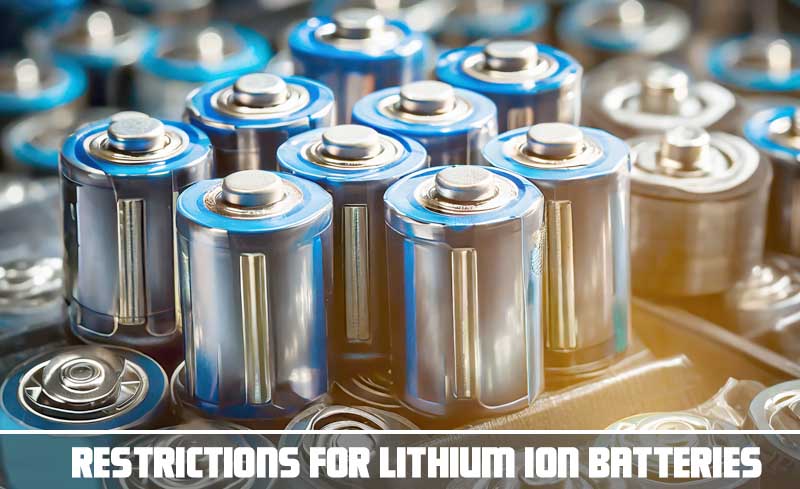
As an experienced traveler, I’ve learned about batteries and air travel. I use lithium-ion batteries in my laptop, phone, camera, and Bluetooth headphones. They help me stay charged while I’m flying. However, not all batteries are cleared for takeoff.
Lithium-ion batteries, like most consumer electronics, are allowed in carry-on luggage only. Spare lithium metal batteries are banned altogether. Why the caution?
At high altitudes, overheating lithium batteries can pose a fire risk. Lithium-ion batteries can come on board if they don’t exceed 100 watt-hours (Wh). Carry-on bags are watched.
Check the label or product specs to find your battery’s Wh rating. My laptop battery is 60 Wh; my phone is 10 Wh, and the camera is 16 Wh – all within limits. But my portable charger is 150 Wh, too powerful to fly. Anything over 100 Wh is grounded.
Watt-hours measure battery energy density, so more Wh means more stored power. While a high Wh is fantastic for long flights, it’s a no-go.
Also, spare batteries should stay at home, even if unnecessary. When you’re flying, it’s best to use the batteries that come with your gadgets.
The Transportation Security Administration (TSA) website details the latest rules on battery types, sizes, and packing tips. Follow their guidelines.
Pack spare batteries in your carry-on, separate from devices. Clearly label them. Keep them in original packaging or protective cases.
As frequent flyers, we should spread the word about lithium battery safety.
Check your Wh ratings, leave powerful spares at home, and fly safely with your tech. We love our devices. But in-flight entertainment is best enjoyed without the worry of overheating batteries!
We can all avoid unwanted adventures by staying up to date with regulations. We can also ensure happy, uneventful travels.
TSA Guidelines on Flying With Batteries and Devices
As a seasoned traveler, I know something about taking batteries and electronics on planes. The most important tip? Familiarize yourself with the TSA guidelines before packing your bags.
The TSA has strict rules for lithium batteries, and for good reason. Lithium metal and lithium-ion batteries can overheat and ignite if damaged or packaged.
The TSA limits lithium-ion batteries to 100 watt-hours per battery to minimize risks. Also, they must contain no more than two grams of lithium content. Watt-hours say how much energy a battery can store. Keep spare batteries under the limit.
When packing, stow lithium batteries in your carry-on luggage, not checked bags. Carry-on bags stay with you. Batteries are less likely to get broken and put safety at risk. Lithium metal spare batteries are not allowed, not even in carry-on bags.
If you need batteries or power banks, ensure you do. Batteries should be kept in their original box or a strong case. Label what’s inside. Do not overcharge your gadgets; if you can, use the battery that came with your device.
The TSA’s website outlines allowable battery types, sizes, and quantities. Check with your specific airline since they may have extra restrictions. Following the guidelines helps ensure we all have a safe flight. It also helps us avoid those unpleasant “Is there an AED onboard?”” moments at 30,000 feet!
Stay up to date with the latest rules. Pack the suitable batteries for your needs. Think before you pack those spares. Have a safe trip, and may the power limits always be on your side! Are there any battery tips you’d like to share?
Conclusion
The rules around lithium batteries and power banks on airplanes may seem complicated. In the end, getting ready takes very little time.
As a seasoned traveler, I know it’s best to call the company for the most up-to-date information. I pack any batteries in my carry-on where I can keep an eye on them.
It may need extra effort. But ensuring safe travel for myself and my fellow passengers is well worth it. The adventure of exploring new places awaits.
We must follow the rules and reach our destination in one piece! What tales do you have to share from your battery-powered travels?
Please let me know if you need anything else!

Jeffrey C. Fields is an experienced travel writer passionate about uncovering the world’s hidden gems. With years of global exploration, he shares unique insights into diverse destinations, offering readers a fresh perspective on our planet’s beauty.

